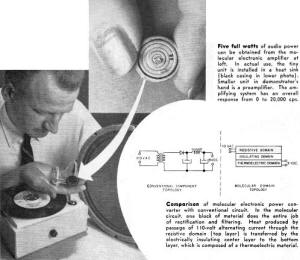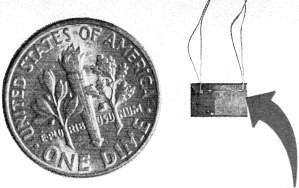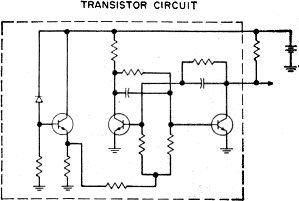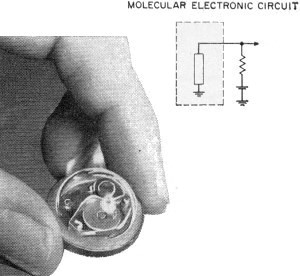|
April 1960 Popular Electronics
 Table
of Contents Table
of Contents
Wax nostalgic about and learn from the history of early electronics. See articles
from
Popular Electronics,
published October 1954 - April 1985. All copyrights are hereby acknowledged.
|
"A transistorized i.f. stage
for a TV set can be built today to fit into a match box. But molecular electronics
has made possible the production of a device that contains two such stages and is
only a fraction of the size of a single transistor!" Nobody talks of molecular electronics
today, but that really is an accurate term for what we have when compound semiconductors
like GaAs, GaN, or any of the many-atomed exotic photovoltaic substrates are being
discussed. When referring to pure elements like silicon that are being doped with
impurities, I'm not sure those structures are considered
molecules which,
according to Dictionary.com, are "the smallest physical unit of an element or
compound, consisting of one or more like atoms in an element and two or more
different atoms in a compound."
Molecular Electronics

Miniaturized audio amplifier.

A five-watt audio amplifier less than the size of a dime and
a two-stage video amplifier much small still... these are among the first products
of an exciting new era, the age of Molecular Electronics.

Size reference of IC.

Multiple junction systems attached to the dendritic
ribbon above are complete multivibrator circuits smaller than the point of a pencil.
These are some of the first molecular electronic circuits to be produced by entirely
automatic machinery. Engineers hope that complete amplifiers, radios, and other
more complex circuits will soon be produced automatically.

Molecular electronics greatly simplifies circuitry.
A conventional transistorized circuit for a light telemetry subsystem is shown in
upper diagram above, with the equivalent molecular electronic circuit below it.
Fewer components and fewer soldered connections will increase reliability of equipment.
Unit in photo is the actual molecular electronic telemetry subsystem.
By J. K. Locke
At a press conference in Washington recently, a demonstrator connected an ordinary
phonograph to a pair of tiny wafers that fitted easily into the palm of his hand.
Then he hooked two leads from the wafers to a 15" loudspeaker. When he flipped a
switch, music filled the room.
The two little discs that did the man-sized job of amplifying the weak signal
from the record player into a hefty five watts of power are striking examples of
some of the first triumphs of "molecular electronics," a startling new design concept
that promises to revolutionize the entire electronics industry.
Molecular electronics is not just a new advance in miniaturization. It is a radically
different approach to electronic design that provides amplifiers, oscillators, and
other complete, operating electronic circuits without tubes, transistors, resistors,
or capacitors.
Five full watts of audio power can be obtained from the molecular
electronic amplifier at left. In actual use, the tiny unit is installed in a heat
sink (black casing in lower photo). Smaller unit in demonstrator's hand is a preamplifier.
The amplifying system has an overall response from 0 to 20,000 cps.
Comparison of molecular electronic power converter with conventional
circuit. In the molecular circuit, one block of material does the entire job of
rectification and filtering. Heat produced by passage of 110-volt alternating current
through the resistive domain (top layer) is transferred by the electrically insulating
center layer to the bottom layer, which is composed of a thermoelectric material.
Although molecular electronics is hardly out of the laboratory, it is already
clear that equipment using its principles will be far smaller, lighter, more reliable,
and ultimately cheaper than anything available today. One example will illustrate
its advantages.
A transistorized i.f. stage for a TV set can be built today to fit into a match
box. But molecular electronics has made possible the production of a device that
contains two such stages and is only a fraction of the size of a single transistor!
. And the molecular electronic unit operates on only a fraction of a volt - much
less than the power required for transistors.
As far as complexity is concerned, a transistorized circuit has perhaps a dozen
components and 35 soldered connections, while a comparable molecular electronic
circuit only has about two parts and four connections.
Integrated Circuitry. The concept of molecular electronics was
developed during the search for better ways to miniaturize electronic equipment.
While great strides had been made in designing smaller and smaller individual components,
it was obvious that far greater miniaturization and reliability could be achieved
if all the necessary electronic properties could somehow be built into a single,
solid block of semiconductor material.
As solid-state physicists gained better understanding of the structure of materials
and the flow of electrical charges in them, it became possible to design simple
"function blocks" containing, for example, both capacitance and resistance. Later,
n- and p-type materials were added to produce amplification as they do in transistors
and tunnel diodes. Finally, scientists were able to produce single bits of material
that would function as complete electronic circuits.
The various electrical properties such as resistance, capacitance, and amplification
are not localized in anyone spot in these function blocks. They are, instead, distributed
throughout the material. Molecular function blocks - even those as complex-looking
as the five-watt audio amplifier with its concentric rings - are not put together
from a number of different parts. Instead, they are cut from a single tiny chunk
of semiconductor material. The block is then etched, alloyed and treated until the
desired results are obtained.
Automatic Production. Engineers are working on the design of
machines that will turn out completed circuits automatically. Although only the
simplest circuits are now produced by automatic machines, great strides have been
made. For example, a method of drawing ribbons of semiconductor material called
"dendrites" directly from the molten mass has already been perfected. These ribbons
are of exact size and thickness, with optically perfect surfaces. They are practically
ready for use as they emerge from the furnace, and there are virtually no rejects.
By contrast, semiconductors are normally made in the form of ingots which must
be x-rayed, oriented, sawed, lapped, etched, and polished before they are ready
to use. In addition, this "old" method results in a high percentage of rejects.
A dendritic ribbon to which tiny multiple-function systems have been automatically
attached is. Here a series of multivibrators has been created directly on the dendrite.
The individual circuits need only be clipped apart and leads attached. Soon, complete
amplifier circuits will be produced the same way. The dendrite ribbon will be snipped
into different lengths to give amplifiers of different gains - the longer the strip,
the greater the amplification!
Eventually, engineers hope to "grow" complex electronic equipment - complete
receivers, for example - automatically and continuously from a pool of semiconductor
material. These receivers are still far in the future, but they would be unbelievably
cheap and trouble - free by today's standards. Because of the low power consumption
of molecular electronic function blocks, a single battery would last for years.
Military Significance. As might be expected, the first
application for molecular electronics will be in the military and space fields.
The savings to be realized in weight, size, and power consumption are of paramount
importance here.
Of even greater significance is the tremendously improved reliability that can
be achieved through the use of these amazing devices. To see why, consider the example
of a giant rocket designed for hurling our satellites into orbit .
The rocket's electronic "innards" are made up of 20 or 30 thousand separate parts
and perhaps 75 thousand connections. If just one of these parts or connections fails,
we suffer another missile failure. With molecular electronic equipment, only one-tenth
to one-twentieth the number of parts and connections is needed. Consequently, there
is much less chance that a part or connection will go bad under strain, and the
promise is that missile firings will be far more successful than ever before.
Molecular electronic units for military use are now being developed by Westinghouse
under a U.S. Air Force contract. Although it takes time to design and test circuits,
set up production lines, and train personnel, the first of these units will be going
into action within about three years.
Consumer Use. It is hard to say when molecular electronic products
will be available for the consumer market. But it is a certainty that such devices
will be on sale some day. Because they will be produced by continuous, automatic,
low-cost production methods, their price is bound to become so low that conventional
tube and transistor circuits - with their separate resistors, capacitors, inductances,
and complex soldered connections - will be on the way out, except possibly for highly
specialized uses.
Molecular electronic devices will open up exciting new fields with their combination
of high performance, small size, and low cost. For example, the wrist radio - a
la Dick Tracy - will become common-place. The personal telephone - a tiny gadget
to strap on your wrist or carry in your pocket - will become possible. With it,
you will be able to call anybody in the world who is similarly equipped.
A flat-screen TV set that hangs on your wall like a picture will become a reality.
Rapid advances in electroluminescence have already come close to making practical
a screen only a fraction of an inch thick. Molecular electronics will make it possible
to pack the rest of the TV circuitry into a hollow corner of the frame!
There are endless speculations possible on the changes molecular electronics
will bring - the probable developments in communications already mentioned are only
a few. But who can say what revolutions in medicine, industry, business, government,
and other phases of human endeavor will come about?
As with most truly revolutionary advances, molecular electronics will bring about
profound changes impossible to predict. We'll be looking forward to them eagerly,
however. For certainly, molecular electronics, whatever its contributions, will
help shape a better and more exciting world for us all.
Posted July 10, 2020
|













